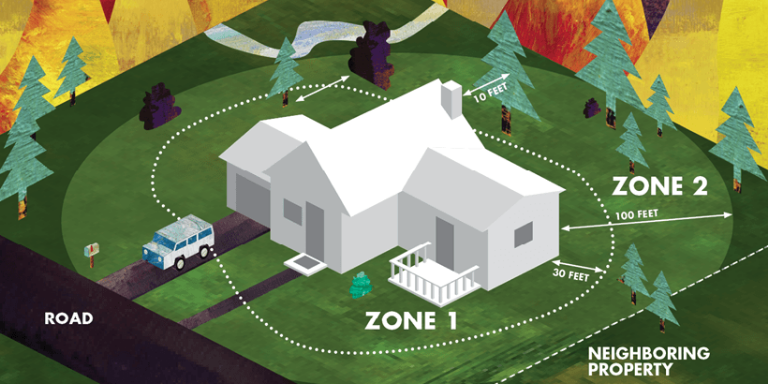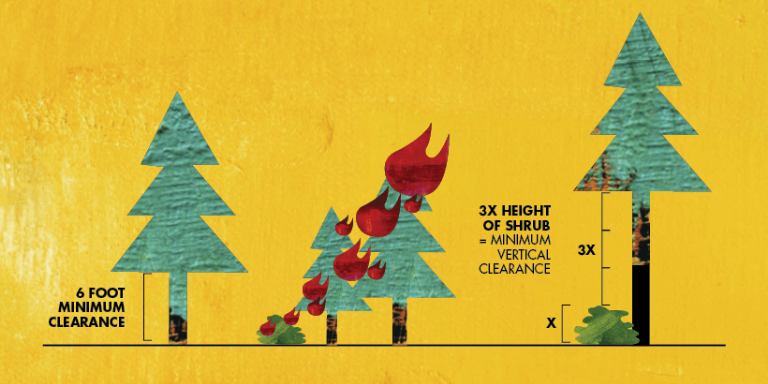Hayward-Fairview-Five Canyons Defensible Space

Defensible Space Fire-Safe Workshops:
The Hayward Fire Department hosted workshops to educate the community about defensible space and other ways they can protect their property from wildfires.
The 2021 series of workshops covered the following topics.
- Creating Defensible Space (Program Kick-off) | Presentation | Meeting Recording
- Wildlife Habitat Preservation | Presentation | Meeting Recording
- Evacuation | Presentation | Meeting Recording
- You can learn about and view a video of the Fire Department's large defensible space project here.
What is defensible space:
Defensible Space is your property’s front line defense against wildfire. Creating and maintaining defensible space around your home can dramatically increase your home’s chance of surviving a wildfire and improves the safety of firefighters defending your property. 100 feet of defensible space is required by law.
This space is needed to slow or stop the spread of wildfire and it helps protect your home from catching fire—either from direct flame contact or radiant heat. Defensible space is also important for the protection of the firefighters defending your home.
Keep your property lean, clean and green.
Two zones make up the required 100 feet of defensible space:
- Extends 30 feet from buildings, structures, decks, etc.
- Extends 100 feet out from buildings, structures, decks, etc.
Creating and maintaining defensible space:
Property owners have a year-round responsibility to maintain defensible space on their property. Effective fire prevention measures can keep fires from starting and reduce hazards that threaten yours and your neighbors’ property.
To create and maintain your 100 feet of defensible space follow these simple steps:
ZONE 1: 30 feet of Lean, Clean & Green
- Remove all dead plants, grass and vegetation.
- Remove dead or dry leaves and pine needles from your yard, roof and rain gutters.
- Keep tree branches 10 feet away from your chimney and other trees.
- Trim trees regularly to keep branches a minimum of 10 feet from other trees.
- Relocate wood piles to Zone 2.
- Remove or prune flammable plants and shrubs near windows.
- Remove vegetation and items that could catch fire from around and under decks.
- Create a separation between trees, shrubs and items that could catch fire, such as patio furniture, wood piles, swing sets, etc.
ZONE 2: 30–100 feet of Reduced Fuel 4
- Cut or mow annual grass down to a maximum height of 4 inches.
- Create horizontal spacing between shrubs and trees.
- Create vertical spacing between grass, shrubs and trees.
- Remove fallen leaves, needles, twigs, bark, cones, and small branches. However, they may be permitted to a depth of 3 inches.
BOTH ZONES:
- Mow before 10 a.m., but never when it’s windy or excessively dry.
- Protect water quality. Do not clear vegetation near waterways to bare soil. Vegetation removal can cause soil erosion—especially on steep slopes.
Use equipment properly to keep from sparking a wildfire:
If you live in a high fire or wildland area, all equipment must be used with extreme caution. Lawn mowers, metal-bladed trimmers, chain saws, grinders, welders, and tractors can all start a wildland fire if not used properly.
Mowing: Metal blades striking rocks can create sparks and start fires in dry grass. Use caution. Remember, it is always best to mow before 10 a.m., and never on a hot or windy day. String trimmers are a safer option (vs. lawnmowers) for clearing vegetation.
Spark Arresters: In wildland areas, spark arresters are required on all portable, gasoline-powered equipment. This includes tractors, harvesters, chainsaws, vegetation-trimmers and mowers.
Keep the exhaust system, spark arresters and mower in proper working order and free of carbon buildup.
Use the recommended grade of fuel, and don’t top it off.
Plant/tree spacing and fire-resistant landscaping:
The spacing between grass, shrubs, and trees is crucial to reduce the spread of wildfire. The spacing needed is determined by the type and size of the shrubs and trees, as well as the slope of the land. For example, a property on a steep slope with larger plant life will require greater spacing between trees and shrubs than a level property that has small, sparse vegetation.
VERTICAL SPACING: Lack of vertical space can allow a fire to move from the ground to the shrubs to the treetops like a ladder.
Remove all tree branches at least 6 feet from the ground. If shrubs are under trees, additional vertical space is needed between the top of the shrub and the lowest tree branch. The space between the top of the shrub and the lowest branches of the tree should be 3 time the height of the shrub.
For example, a five foot shrub is growing near a tree: 3×5 feet = 15 feet of clearance needed between the top of the shrub and the lowest tree branch.

HORIZONTAL SPACING: depends on the slope of the land and the height of the shrubs or trees.
- Flat to mild slope (less than 20%): Space between shrubs should be at least 2x the height of the shrubs. Space between trees should be at least 10 feet.
- Mild to moderate slope (20% - 40%): Space between shrubs should be at least 4x the height of the shrubs. Space between trees should be at least 20 feet.
- Moderate to steep slope (greater than 40%): Space between shrubs should be at least 6x the height of the shrubs. Space between trees should be at least 30 feet.
FIRE-RESISTANT LANDSCAPING: uses fire-resistant plants that are strategically planted to resist the spread of fire to your home. Fire resistant plants are great in California because they are often drought tolerant, too.
- Create fire-resistant zones with stone walls, patios, decks and roadways.
- Use rock, mulch, flower beds and gardens as ground cover for bare spaces and as effective firebreaks.
- There are no “fire-proof” plants. Select high-moisture plants that grow close to the ground and have a low sap or resin content.
- Choose fire-retardant plant species that resist ignition such as rockrose, ice plant and aloe.
- Select fire-resistant shrubs such as hedging roses, bush honeysuckles, currant, cotoneaster, sumac and shrub apples.
- Plant hardwood, maple, poplar and cherry trees that are less flammable than pine, fir and other conifers.
Check your local nursery, landscape contractor or county’s UC Cooperative Extension service for advice on fire-resistant plants that are suited for your area.
- City of Hayward Fire Prevention Code
- City of Hayward Community Preservation and Improvement Code
- City of Hayward Vegetation, Rubbish and Litter Abatement Code
- Preventative Measures for the Hayward Hills
- Calfire's Ready for Wildfire Program
- Defensible Space PSA Video
- Horizontal Spacing Diagram
- Defensible Space Informational Brochure
- Defensible Space Flyer and Checklist
- Homeowners Fire Safety Checklist
- CalFire Defensible Space Photos
- Fire Resistant Plants


